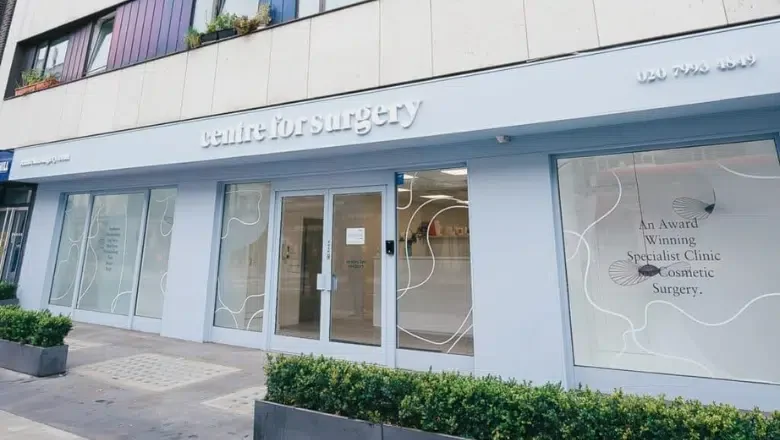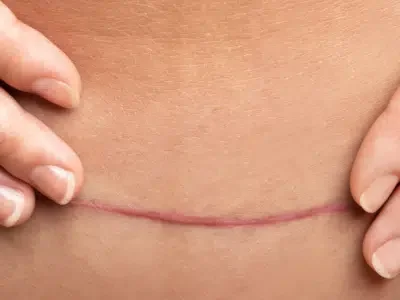Body Lift surgery, also known as Massive Weight Loss Surgery or post-bariatric body contouring, can indeed be a transformative procedure that can significantly impact a person’s life. It is particularly beneficial for individuals who have loose, saggy skin, uncomfortable skin folds (which can sometimes lead to infections), or those who have undergone significant weight loss through bariatric surgery. At Centre for Surgery, we specialise in performing Body Lift procedures after massive weight loss with utmost professionalism and safety. Our priority is to minimise risks and ensure that you achieve a happier and healthier body. To help you make an informed decision, we have provided answers to frequently asked questions about Body Lift surgery below.
RELATED: Body Shaping Surgery after Massive Weight Loss
How can I get rid of a sagging belly?
If you are experiencing saggy belly skin, the most effective solution is a body lift procedure. At the Centre for Surgery, we specialise in performing Lower Body Lift procedures, which are highly successful in removing excess skin from the lower body areas.
Will I have loose skin if I lose 20kg?
Yes, it is likely that you will have loose skin if you lose 20kg. While the skin has some elasticity and can tighten to a certain extent, significant weight loss can result in excess skin that may not fully restore its former shape and size. A body lift procedure can address loose skin, skin folds, saggy skin, or an apron belly.
What is the best way to prevent saggy skin when losing weight?
Maintaining proper skin health and hydration can help the skin retain its elasticity to some extent. However, it’s important to note that the skin’s elasticity has limits, and massive weight loss may lead to loose skin. In such cases, surgical intervention may be necessary to remove the excess skin and achieve a more contoured appearance.
What does a full body lift involve?
A full-body lift, also known as body contouring surgery, encompasses a range of procedures that lift and tighten the entire body. It involves removing excess skin and, in some cases, fat deposits from various areas, including the arms, breasts, abdomen, hips, thighs, and buttocks.
How much weight can you lose with a lower body lift?
It’s important to note that a lower body lift is not a weight loss surgery itself. It is a procedure performed after significant weight loss to remove excess skin. The amount of weight lost during the procedure depends on the extent of loose skin removed by the surgeon.
What is a body lift?
A body lift is a transformative surgical procedure that involves the removal of excess skin and fat deposits, resulting in a more sculpted and healthier appearance.
What is a 360 body lift?
A 360 body lift, also known as a belt lipectomy, is a surgical procedure that targets excess fat and skin around the stomach, hips, and back. The incision extends around the entire circumference of the body. This procedure reshapes and tightens the mid-section.
What is a circumferential body lift?
A circumferential body lift is a surgical procedure that involves making incisions around the waistline to address loose, saggy skin on the abdomen, back, and hips. It is an excellent option for individuals who have lost a significant amount of weight and desire a firmer and tighter appearance.
What is a lower back lift?
A lower back lift is a surgical procedure that removes excess skin and fat from the back, hips, and buttocks. This procedure eliminates sagging skin and can also help reduce stubborn fat tissue in the lower back, leading to a more defined appearance.
What is a belt lipectomy?
A belt lipectomy is a major surgical procedure that removes excess skin and fat deposits from the lower backside and hips. It is an effective solution for individuals who desire a more contoured lower body appearance.
What is a 360 tummy tuck?
A 360 tummy tuck, or a 360 abdominoplasty, is a surgical procedure that addresses excess skin and fat around the entire stomach circumference. It provides comprehensive improvement by tightening and sculpting the entire abdominal area.
What is a skin lift procedure?
A skin lift refers to any surgical procedure that removes excess skin folds to improve skin tightness and reduce sagging or skin laxity. It can be performed on various body areas, including the thighs, buttocks, abdomen, lower back, chest, breasts, neck, face, and arms.
RELATED: Apronectomy To Remove Loose Tummy Skin
What does an upper body lift include?
An upper body lift is a surgical procedure that involves removing excess skin and, in some cases, fat tissue from the upper back, side of the chest, or even the sides of the body. The goal is to improve skin elasticity and address side-to-side skin laxity. It is often recommended after significant weight loss to achieve a more balanced and contoured upper body appearance.
What does a lower body lift include?
A lower body lift combines the benefits of a tummy tuck and a lower back lift. This comprehensive procedure removes excess skin and fatty tissue from the abdominal area as well as the lower back. It targets sagging skin and fat deposits to enhance the overall shape and contour of the lower body.
What can a 360 body lift achieve?
A 360 body lift is designed to address excess skin and fat around the entire waistline. The surgical incision encompasses the entire circumference of the body, allowing for comprehensive removal of loose skin. This procedure tightens and reshapes the mid-section, resulting in a more defined and toned appearance.
What is the difference between a tummy tuck and a lower body lift?
The main difference between a tummy tuck and a lower body lift lies in the scope of the procedures. While a tummy tuck focuses solely on the abdomen, removing saggy skin and fat deposits, a lower body lift addresses excess skin and fat not only in the abdominal area but also in the back. A tummy tuck is typically recommended for individuals who have experienced some weight loss or undergone multiple pregnancies. On the other hand, a lower body lift is often more suitable for individuals who have lost a significant amount of weight, resulting in excess skin across multiple body areas.
What is the difference between a belt lipectomy and a tummy tuck?
The main difference between a belt lipectomy and a tummy tuck lies in the areas of the body where excess skin is removed. While a tummy tuck primarily focuses on the abdomen, a belt lipectomy involves the removal of excess skin in the belt area, covering the entire circumference of the body, including the front, sides, and back. The incision for a tummy tuck is typically made below the beltline, while a belt lipectomy requires incisions around the waistline. The choice between the two procedures depends on the extent of excess skin and the desired outcome for each individual case.
SUITABLE CANDIDATES
How do I know if I need a body lift?
Consider a body lift procedure if you have:
- Lost a significant amount of weight and maintained it.
- Undergone pregnancy or multiple pregnancies.
- Saggy skin on the upper arms, belly, hips, thighs, or buttocks.
- An “apron belly” causes discomfort or self-esteem issues.
- Excess skin that makes you unhappy with your body.
- Social or intimate activities that you avoid due to the presence of extra skin.
Am I suitable for body lift surgery?
If you have lost a significant amount of weight through diet and exercise, undergone bariatric surgery resulting in substantial weight loss, experienced multiple pregnancies leading to loose skin, or have an apron belly causing difficulties in daily activities, you may be a suitable candidate for a body lift surgery. It is important to have realistic expectations regarding the outcomes that can be achieved through the procedure.
PREPARATION
How do I prepare for a body lift?
Preparing your body for plastic surgery, including a body lift, involves several steps. It is beneficial to be as close to your desired weight and body mass index (BMI) as possible. Achieving your goal weight and maintaining it for at least one year is crucial for a successful surgery and smooth recovery. Losing approximately 20 to 30 kilograms of fat can make you a potential candidate for a body lift, along with having a BMI of 30 or lower.
Will I need to diet before a body lift?
Yes, it is advisable to follow a diet before undergoing a body lift procedure. It is important to note that a body lift is not a weight-loss solution. While the procedure can remove some fat tissue, its primary focus is on eliminating excess skin. To optimise the results of the body lift, you should be as close to your desired weight as possible before the surgery. Maintaining a healthy diet and lifestyle can contribute to achieving the best possible outcomes.
Do I need to lose weight before body lift surgery?
Losing weight before a body lift surgery can be beneficial as it helps create the necessary skin laxity for the procedure. Following the surgery, it may be relatively easier to maintain a healthy and fit figure, as the body lift removes excess skin and provides a more sculpted appearance. However, it is important to note that a body lift is not primarily a weight-loss procedure. Try to reach your desired weight and maintain it before considering a body lift surgery for optimal results.
How much weight should you lose before a body lift?
The amount of weight you should aim to lose before a body lift can vary depending on individual circumstances. Generally, losing anywhere between 18 and 30 kilograms can create the necessary skin laxity for a body lift surgery. The goal should be to lose as much weight as possible to get as close as possible to your desired weight and body composition. A specialist plastic surgeon can evaluate your specific case and provide personalised recommendations regarding weight loss and the suitability of a body lift procedure.
What items should I pack on the day of my body lift procedure?
When preparing for a body lift surgery, it is recommended to bring the following items:
- Any lab results or medical documentation that your surgeon has requested.
- Your compression garment, if provided or instructed by your surgeon.
- Any medications you take regularly, along with a list of their names and dosages.
- Loose and comfortable clothing that is easy to put on and take off, as you may experience some post-operative swelling and discomfort.
- Personal items such as a mobile phone, tablet, books, or magazines to keep yourself occupied during the recovery period.
- Any other items that may contribute to your comfort and well-being during your stay at our Baker Street clinic
What clothing should I wear on the day of surgery?
When attending a body lift surgery procedure at Centre for Surgery, wearing loose and comfortable clothing that is easy to put on and take off is recommended. This is especially important for the post-operative period, as you may experience some swelling and limited mobility. Choose clothing that does not put unnecessary pressure or friction on the surgical areas. Cleanliness is also important, so make sure your clothing is freshly washed. Follow any specific instructions we provide regarding attire for the surgery day.
PROCEDURE DETAILS
What does a body lift involve?
A body lift is a comprehensive surgical procedure that addresses excess skin and, to some extent, removes fat deposits in multiple areas of the body. The areas commonly targeted in a body lift include the thighs, buttocks, tummy, hips, lower back, upper back, and arms. The surgery is typically performed under general anaesthesia.
During the procedure, your specialist plastic surgeon will strategically place incisions to minimise visible scarring. They will remove excess fat tissue, stretch the remaining skin, and trim any loose or sagging skin. The underlying muscles may also be tightened if necessary. After the necessary adjustments have been made, the surgeon will carefully reposition and secure the remaining skin using sutures or other techniques. The incisions will then be closed, and dressings or compression garments may be applied to aid in the healing process.
Is fat removed in body lift surgery?
While body lift surgery primarily focuses on removing excess skin, it may also involve removing some fat tissue. However, it’s important to note that a body lift is not primarily intended as a weight loss procedure. Its main goal is to address skin laxity and contour the body after significant weight loss or other factors that have led to excess skin.
The extent of fat removal during a body lift surgery varies depending on individual circumstances and the specific areas being treated. Your surgeon will discuss the expected outcomes and potential fat removal during the consultation process.
How long does a body lift surgery take?
The duration of a body lift surgery can vary depending on the specific procedures involved, the extent of the surgery, and individual patient factors. An upper body lift may take a few hours, while a lower body lift generally takes between 4 to 6 hours. A full-body lift, which combines both upper and lower body lifts, is a more extensive procedure and may take several hours.
The duration of the surgery can vary based on individual cases, the complexity of the surgery, and any unforeseen circumstances that may arise during the procedure. Your surgeon will provide you with a more accurate estimate of the expected surgery duration based on your specific situation.
Will I be asleep during body lift surgery?
Yes, body lift surgery is typically performed under general anaesthesia. This means you will be completely unconscious and unaware during the procedure. An experienced anaesthetist will administer the general anaesthesia and closely monitor your vital signs throughout the surgery to ensure your safety and comfort. The use of general anaesthesia allows for a pain-free and controlled surgical experience.
RECOVERY AND HEALING
Is a body lift surgery painful?
The pain following a body lift procedure is typically most intense during the first few days after surgery. However, as time passes, the pain gradually subsides. Over-the-counter pain relievers are usually sufficient to manage any discomfort experienced during the recovery period.
How painful is a lower body lift?
Pain during the recovery period of a lower body lift is generally manageable with over-the-counter pain medication. Following your surgeon’s instructions regarding pain relief and limiting excessive movement during the initial week post-op is crucial. By the end of the first week, most of the pain should diminish as your body continues to heal.
How long does it take to recover from a body lift?
The recovery time for a body lift surgery can vary depending on individual factors and the extent of the procedure. Most people generally need approximately four to six weeks to recover from a body lift. However, it is important to note that everyone’s body heals at a different pace, influenced by factors such as overall health, age, and lifestyle choices. The recovery period may seem longer compared to other plastic surgery procedures due to the extensive nature of the surgery and the need for adequate healing time.
RELATED: Recovery After Full Body Lift Surgery
During the initial two weeks after surgery, it is common to experience some limitations and discomfort. However, by this time, you should be able to gradually resume some of your daily activities under your surgeon’s guidance. Non-strenuous activities can be reintroduced, but following your surgeon’s instructions and avoiding any activities that could strain or compromise the healing process is essential.
What is the best sleeping position after a lower body lift?
After a lower body lift, it is typically recommended to sleep on your back in an elevated position during the initial recovery period. This helps minimise tension on the surgical area and promotes optimal healing. Placing a pillow or cushion under your legs can help elevate them slightly, reducing strain on the lower back and ensuring a more comfortable sleeping position. Prioritise adequate sleep and create a stress-free sleeping environment to support the healing process.
Your surgeon will provide specific instructions tailored to your individual case and may recommend additional measures or modifications to your sleeping position based on your unique circumstances and the details of your surgery.
How long do you wear a compression garment after a lower body lift?
The duration of wearing a compression garment after a lower body lift will be determined by your surgeon’s recommendations. In general, the compression garment should be worn continuously for the first six weeks following surgery. The compression garment plays a crucial role in supporting the healing tissues, reducing swelling, and promoting optimal results.
RELATED: Compression Garments after Body Lift Surgery
Occasionally, you may need to remove the compression garment temporarily for activities such as showering or washing the garment. Follow your surgeon’s instructions regarding the appropriate duration and frequency of these breaks to ensure that the compression and support provided by the garment are consistently maintained.
Does wearing a compression garment help to tighten the skin?
Compression garments do not directly tighten the skin. Their primary role is to provide support, compression, and stabilisation to the surgical area during the healing process. By exerting gentle pressure on the tissues, compression garments help minimies swelling, promote better circulation, and aid in the retraction and remodelling of the skin.
While compression garments do not have the ability to tighten loose or sagging skin on their own, they contribute to better healing outcomes, minimise postoperative complications, and can enhance the overall appearance and contour of the body after the recovery period.
When can I stand up straight after body lift surgery?
Most patients should be able to stand up straight approximately one week after body lift surgery. Please note that individual recovery times can vary. Factors such as the extent of the surgery, individual healing rates, and any specific post-operative instructions from your surgeon can influence the timing of being able to stand up straight comfortably.
During the initial recovery period, it is common to experience some temporary hunching or discomfort when attempting to stand up straight. This is due to the tightness and tension in the surgical area. As the healing progresses, the muscles and tissues will gradually relax, allowing you to stand up straight more comfortably.
SAFETY
Is excess skin removal surgery safe?
Skin removal surgery, when performed by an experienced plastic surgeon in a safe clinical environment, is generally a safe procedure. However, like any surgery, there is a slight possibility of discomfort and complications. Make sure to provide your specialist plastic surgeon with accurate and truthful information during the consultation to ensure your safety and the best possible outcome.
Is body lift surgery safe?
All surgical procedures carry some level of risk. However, you can minimise these risks by choosing a specialist plastic surgeon who has the necessary experience, a skilled support team, access to a well-equipped operating theatre, and the appropriate training to perform the procedure. Follow all pre-and postoperative instructions provided by your surgeon to optimise your safety and recovery.










